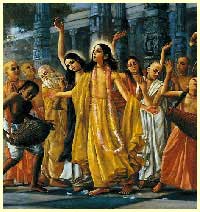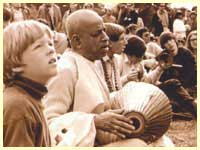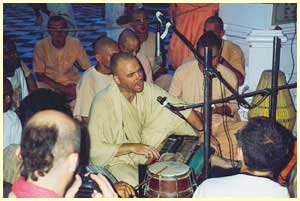
“The Absolute Truth is Sri Krishna,
and loving devotion to Sri Krishna exhibited in pure
love is achieved through congregational chanting of the
Holy Name, which is the essence of all bliss.” (Sri
Caitanya-caritamrita, Adi 1.97) Or, as Narottama
Dasa Thakura puts it: “The treasure of divine love in
Goloka Vrindavan has descended as the congregational
chanting of Lord Hari’s Holy Names.”

Even in former ages, when more difficult processes were
recommended, the goal was always
bhakti, or
devotion to the Supreme Lord. In this age the most
accessible form of
bhakti is sankirtana, or
congregational chanting of the Holy Names of God. It is
the yuga-dharma,
the religion and saving grace of this age.
“My dear king,” Sukadeva Gosvami told King Pariksit,
“although Kali-yuga
is an ocean of faults, the one good quality about it is
that simply by chanting the Hare Krishna
maha-mantra,
one can become free from material bondage and be
promoted to the transcendental kingdom” (SB 2.3.51).
Human life is especially meant for self-realization.
Yet, owing to a bad educational system, people have no
desire for self-realization. This is the hallmark of the
age of Kali. We have short lives, and we tend to be
“quarrelsome, lazy, misguided, unlucky and, above all,
always disturbed.” And yet each one of us, being a pure
spirit soul, originally has all good qualities. All we
need to do is cleanse our mind from the dirty thoughts
and desires that have accumulated there over countless
lifetimes. Like thick dust over a mirror, these dirty
things prevent us from understanding our spiritual
identity. Therefore, great saints in the devotional line
strongly recommend the process of hearing and chanting
to cleanse the mind and bring out our dormant good
qualities. In his
Mukunda-mala stotra (42), the self-realized saint
King Kulasekhara of the Sri-sampradaya recommends hari-nama,
in the form of both congregational chanting (sankirtana) and individual meditation (japa). (…)
 Sri Caitanya Mahaprabhu, the Golden Avatar of Krishna,
spread the chanting of the Hare Krishna
maha-mantra
throughout India, and He predicted that one day the Holy
Names would be heard and chanted in every town and
village of the entire world. His prediction came to pass
in 1965, when His Divine Grace A. C. Bhaktivedanta Swami
Prabhupada, a powerful disciple in Sri Caitanya
Mahaprabhu’s tradition, sailed to New York and began the
Hare Krishna Movement, which has spread to all major
cities of every continent—and further. Sri Caitanya Mahaprabhu, the Golden Avatar of Krishna,
spread the chanting of the Hare Krishna
maha-mantra
throughout India, and He predicted that one day the Holy
Names would be heard and chanted in every town and
village of the entire world. His prediction came to pass
in 1965, when His Divine Grace A. C. Bhaktivedanta Swami
Prabhupada, a powerful disciple in Sri Caitanya
Mahaprabhu’s tradition, sailed to New York and began the
Hare Krishna Movement, which has spread to all major
cities of every continent—and further.
Through
harinama-sankirtana, Ratha-yatra festivals, and the
massive distribution of sanctified foods and books
expounding the philosophy of Krishna consciousness, the
Hare Krishna Movement grew from strength to strength.
But His Divine Grace Srila Prabhupada did not just want
to attract people. He wanted to keep them and turn them
into lovers of God, Krishna.
And the main symptom of a person in love is that
he or she cannot live without speaking of the beloved.
Although it is true that the
brihad-mridanga
(the printing press) can be heard farther than the clay
mridanga, Srila Prabhupada wanted the devotees to chant and dance in
front of the Deities every morning and evening. And he
wanted us to chant sixty-four rounds of
japa every
day, although eventually he came down to sixteen because
we couldn’t come up to the mark. And he said that
everything we do “must be accompanied by the chanting of
the Holy Name.”
In India especially, where materialism wasn’t as
all-pervasive as in the West, Prabhupada asked the
devotees to chant for longer periods of time. In Juhu,
Mumbai, he told the temple president that all the
devotees should sit down together for a twelve-hour
kirtana every
Sunday—even though
 at that time the devotees were
intensely busy working toward the completion of the Radha-Rasabihari temple complex. And in Vrindavan, the
transcendental abode of Lord Krishna, he wanted all the
visiting devotees and whoever else had spare time to
take part in a continuous 24-hour
kirtana.
Things started quite harmoniously, with groups of men
and women taking turns to lead the
kirtanas.
Srimati Daivisakti remembers starting her shift at one
o’clock in the morning until, in March of 1978, an
all-male Nama-hatta crew took over the 24-hour
kirtana. Then, in 1979, the leadership changed and there wasn’t much
kirtana going
on at the Krishna-Balarama Mandir. Then again, in 1984,
signs of kirtana revival appeared, only to vanish with the arrival of summer.
In brief, it wasn’t until Aindra Dasa came from New York
City in 1986 that the legendary 24-hour
kirtana
emerged as a reality. at that time the devotees were
intensely busy working toward the completion of the Radha-Rasabihari temple complex. And in Vrindavan, the
transcendental abode of Lord Krishna, he wanted all the
visiting devotees and whoever else had spare time to
take part in a continuous 24-hour
kirtana.
Things started quite harmoniously, with groups of men
and women taking turns to lead the
kirtanas.
Srimati Daivisakti remembers starting her shift at one
o’clock in the morning until, in March of 1978, an
all-male Nama-hatta crew took over the 24-hour
kirtana. Then, in 1979, the leadership changed and there wasn’t much
kirtana going
on at the Krishna-Balarama Mandir. Then again, in 1984,
signs of kirtana revival appeared, only to vanish with the arrival of summer.
In brief, it wasn’t until Aindra Dasa came from New York
City in 1986 that the legendary 24-hour
kirtana
emerged as a reality.

(Excerpts from an article compiled
by Vishaka-priya Mataji,
Kirtana Ashrama,
Vrindavan)
More details about Aindra Prabhu and the 24-hour
kirtana can be
found under the
“life”-section of this web page.
|
